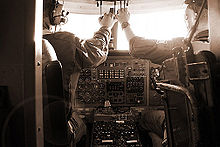IAI Arava
| IAI Arava | |
|---|---|
 Colombian arava |
|
| Type: | Transport plane |
| Design country: | |
| Manufacturer: | |
| First flight: |
November 27, 1969 |
| Production time: |
1972 to 1988 |
| Number of pieces: |
> 89 |
The IAI Arava is a light twin-engine transport aircraft produced by the Israeli manufacturer Israel Aircraft Industries .
The Arava was the first larger aircraft designed by IAI. Until 1988 a relatively small number of units was built for the military and civilian market. Most of the customers came from the Third World, including countries in Central and South America , but also from Swaziland and Thailand .
history
The design work began in 1966. The requirements were STOL capability, the ability to operate makeshift airfields and a load of 25 soldiers or bulky payloads. To achieve this, the Arava was given an unusual configuration. The trunk was very short and wide, the wingspan large. The double tail unit was attached to outriggers that attached to the motor nacelles. The drive consisted of two Pratt & Whitney Canada PT6A turbo-prop engines.
The Arava flew for the first time on November 27, 1969, a second prototype on May 8, 1971. Production ended in 1988. More than 90 aircraft have been built, including 70 military aircraft. They are still in service in some countries.
Versions
- IAI 101 - civil transport version
- IAI 102 - civil passenger aircraft for up to 20 people in passenger service or up to 12 people in VIP configuration
- IAI 102B - civil transport version
- IAI 201 - military transport version
- IAI 202 - stretched version with modified wings
Users
-
 Argentina
Argentina
-
 Bolivia
Bolivia
-
 Ecuador
Ecuador
-
 El Salvador
El Salvador
-
 Guatemala
Guatemala
-
 Haiti
Haiti
-
 Honduras
Honduras
-
 Israel
Israel
-
 Liberia
Liberia
-
 Cameroon
Cameroon
-
 Colombia
Colombia
-
 Mexico
Mexico
-
 Nicaragua
Nicaragua
-
 Papua New Guinea
Papua New Guinea
-
 Swaziland
Swaziland
-
 Thailand
Thailand
-
 Venezuela
Venezuela
Incidents
- On November 19, 1979, an IAI Arava 201 of the Ecuadorian Air Force ( aircraft registration FAE T-201 ) had an accident while taking off at Catamayo Airport , Ecuador. All 16 inmates perished.
Technical specifications
| Parameter | Data |
|---|---|
| crew | 2 |
| Passengers | 12-24 |
| length | 13.00 m |
| span | 20.90 m |
| height | 5.20 m |
| payload | 2800 kg |
| Takeoff mass | 6803 kg |
| Cruising speed | 319 km / h |
| Top speed | 397 km / h |
| Service ceiling | 7315 m |
| Range | 1300 km maximum; 323 km with a full load |
| Engines | Propeller turbines Pratt & Whitney Canada PT6 A34 with 575 kW each |
Armament
The military version can also be used for fighting submarines or as a light attack aircraft. For this purpose, an armament with two side-mounted machine guns and a third at the rear is provided. Unguided rockets in caliber 68 and 82 mm as well as torpedoes can be attached to the side pods. The anti-submarine variant includes two Mk.44 torpedoes and twelve sonar buoys.
- 2 × 12.7 mm FN Herstal M3P machine guns with 250 rounds of ammunition each in a forward-facing aerodynamic container on the side of the fuselage
- 1 × 12.7 mm FN Herstal M3P machine gun with 250 rounds of ammunition in a rear-facing aerodynamic container in the rear
- 2 × rocket tube launch containers for 6 unguided air-to-ground missiles each; Caliber 81 mm
- 2 × rocket tube launch containers for 7 unguided air-to-ground missiles each; Caliber 68 mm
- 2 × Mk.44 torpedo
- 12 × sonar buoys
See also
- List of aircraft types
- de Havilland Canada DHC-6 Twin Otter
- Antonov An-28
- CASA C 212-200
- Short SC7 Skyvan
- North Noratlas
Web links
Individual evidence
- ^ Accident report IAI Arava FAE T-201 , Aviation Safety Network (English), accessed on March 9, 2019.
